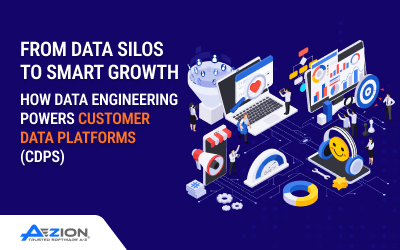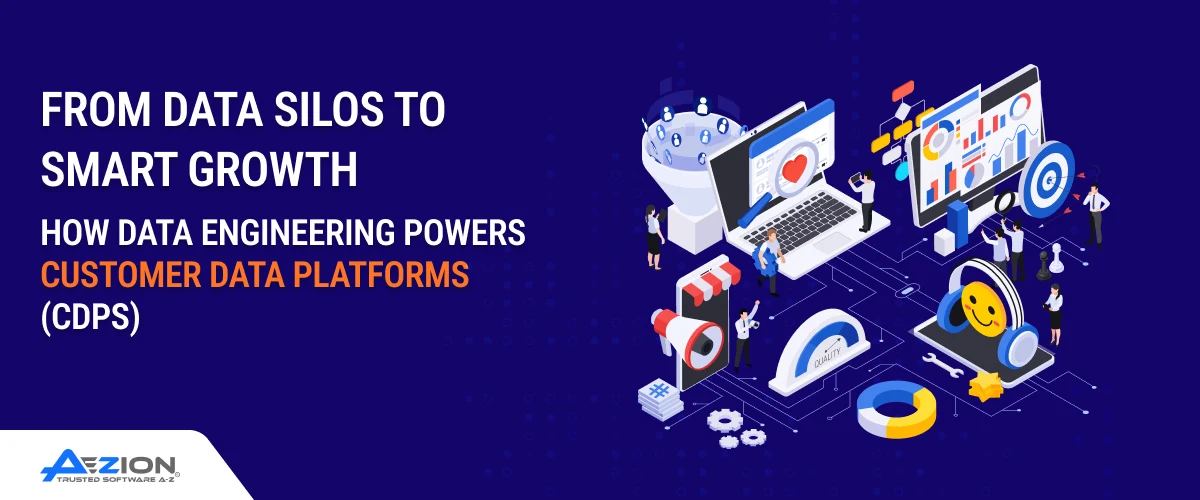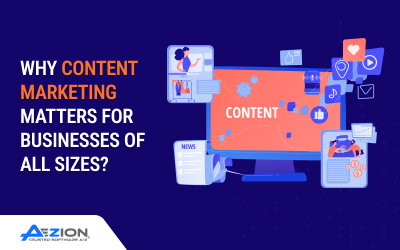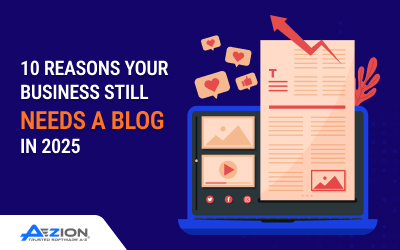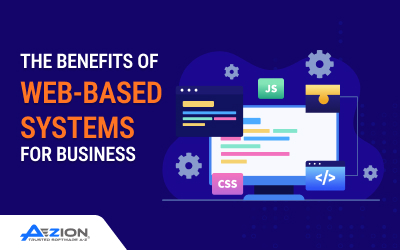Introduction
In the age of hyperconnection, information is created at an unprecedented pace, and at the heart of this digital boom is customer information. Companies gather it from all factors: purchases, site visits, support requests, emails, and mobile apps. But there’s a twist here, much of this information is still siloed or unutilized.
Customer data is one of today’s most powerful yet underused business assets. Untapped, it’s just noise. But when properly combined, organized, and activated, it can drive personalized experiences, revenue growth, and lasting loyalty.
This is where Customer Data Platforms (CDPs) come in and where data engineering comes into the picture. A CDP fueled by solid data engineering capabilities helps organizations combine disjointed data, create a 360-degree view of the customer, and operationalize insights at scale.
In this post, we discuss how to realize the complete potential of customer data by converting it from a hidden asset into an actionable ROI driver. You’ll discover why most businesses fall short regarding customer data, the strategic power of getting it right, and how you can harness a CDP, supported by robust data engineering, to make your marketing more intelligent, quicker, and more successful.
The Untapped Potential of Customer Data
What Counts as Customer Data Today?
In the age of digital-first business, customer data goes far beyond simple demographics. It captures every interaction and touchpoint a customer has with your company, both online and offline. Some of the most important types of data include:
- Behavioral Data: Web clicks, session length, email openings, mobile app activity.
- Transactional Data: History of purchases, abandoned shopping carts, returns, and renewal of subscriptions.
- Demographic Data: Age, gender, location, income group, occupation.
- Psychographic Data: Interests, values, lifestyle, and attitude towards a brand.
- Engagement Data: Customer support requests, chatbot interactions, social media posts.
This multi-faceted data is collected from CRMs, ERPs, web analytics suites, customer support portals, eCommerce platforms, and marketing software. Yet, this vast array of information lies disorganized without a unified data infrastructure and intelligent data integration, both central tenets of data engineering.
Why Most Businesses Struggle to Leverage Customer Data
Most businesses cannot unlock their value even after gathering vast customer data. Here’s why:
- Data Silos: Marketing, sales, support, and operations all maintain isolated data systems with no single access. This results in inconsistent messaging and a negative customer experience.
- Inconsistent Data Quality: Duplicate entries, incomplete fields, and stale data reduce faith in data-driven decisions.
- Limited Real-Time Access: Legacy architectures cannot handle real-time personalization, predictive analytics, or dynamic audience segmentation.
- Insufficient Data Engineers with Skills: Organizations lack the technical competence to create scalable data pipelines to clean, enrich, and consolidate customer data.
- Inadequate Governance and Compliance Procedures: With stringent data privacy regulations such as GDPR and CCPA, companies risk non-compliance if they manage customer data poorly.
Business Value of Strategic Data Utilization
Benefits of a Customer-Centric Data Strategy
When companies transition from piecemeal data handling to a strategic, customer-focused strategy, fueled by a robust data engineering foundation, the payoffs are real and frequently multiplicative. Here’s how an intelligent data application brings business value:
- Improved Personalization and Customer Experience
With harmonized and enriched customer profiles, companies can personalize messages, product recommendations, and experiences at the individual level. Personalization is an expectation. And data engineering makes these experiences occur in real time, across channels.
- Increased Retention and Lift in Customer Lifetime Value (CLV)
With insights into behavior patterns, preferences, and churn signals, brands can create more targeted loyalty programs, upsell initiatives, and re-engagement campaigns. All these things are fueled by high-quality data pipelines.
- Faster, Data-Driven Decision-Making
Data-driven insights enable marketing, product, and sales teams to act quickly. Decisions are no longer made on hunches but driven by insights created through properly architected data systems.
- Cross-Team Alignment and Efficiency
A single source of truth for customer data saves time reconciling report discrepancies or tracking down data. Marketing, analytics, and engineering teams can share the same truth.
- Better Campaign ROI
Teams derive more value from each dollar invested, from improved targeting to real-time optimization. CDPs based on up-to-date data engineering can even automate this loop of feedback.
Risks of Inaction
Overlooking customer data’s strategic value not only leaves money on the table, but it also exposes it to risk. Here’s what could go wrong:
- Wasted Marketing Spend
Lacking proper targeting, companies overspend on ads that fail to convert or target the wrong customer segments.
- Low Customer Engagement and Churn
Erratic experiences and cookie-cutter messaging drive today’s customers away, particularly when competitors offer tailored journeys.
- Regulatory and Compliance Exposure
Bad data governance can infringe on GDPR, CCPA, and other privacy regulations, culminating in fines and reputational loss.
- Lost Opportunities for Growth
Data-blind companies are less able to identify new market segments, product opportunities, or changing customer behavior.
Short of it, customer data is no longer a marketing asset. It’s a business-critical asset. Its potential is only realized when data engineering solutions deliver the architecture to bring together, manage, and activate it.
What Is a Customer Data Platform (CDP)?
Defining the CDP
A Customer Data Platform (CDP) is a computer program that aggregates and structures customer data across various touchpoints into a unified, centralized representation. It differs from legacy data warehouses or CRMs in that it is designed explicitly for marketing and customer experience applications, with real-time, identity resolution, and audience segmentation at its foundation.
At its core, a CDP consumes raw data, cleans it, consolidates profiles, and activates it across downstream systems, including email platforms, advertising platforms, and personalization engines. And this entire pipeline is powered by data engineering principles such as data ingestion, transformation, orchestration, and governance.
How It Differs from Other Martech Tools
Getting a CDP mixed up with other data systems is simple, but its special mission is centralization and activation. Here’s how it differs:
| Purpose | Key Limitations | CDP Advantage | |
| CRM (Customer Relationship Management) | Manages sales and service interactions | Stores structured data only; limited real-time insights | CDPs integrate CRM data with behavioral and unstructured inputs |
| DMP (Data Management Platform) | Collects anonymous third-party data for ad targeting | Short data retention, no persistent identity | CDPs focus on first-party data with persistent user profiles |
| Data Warehouse | Stores large volumes of structured data | Not marketer-friendly; requires technical queries | CDPs offer an accessible UI for marketing activation |
| Marketing Automation Tools | Deliver emails, push notifications, and ads | Rely on static lists; limited personalization | CDPs enable dynamic segmentation based on live behavior |
Why CDPs Are Gaining Momentum
The increased privacy laws, third-party cookie deprecation, and the imperative for first-party data strategies have hastened CDP adoption. With businesses going data-driven to grow, a CDP helps them:
- Eliminate guesswork with actual insights
- Provide hyper-personalized marketing at scale
- Simplify omnichannel customer journeys
- Enhance compliance with secure, governed data frameworks
However, a CDP’s real potential is unlocked only when it’s deployed over a well-architected data engineering stack with data pipelines, cloud-native infrastructure, and real-time streaming to provide scalability and performance.
How CDPs Work: Behind the Scenes of Customer Intelligence
Understanding what a CDP does is one thing, but it helps to know that the true strategic benefit comes in. At the heart of every high-flying CDP is an up-to-date data engineering platform that prevents data from being gathered and made unusable, scalable, and secure.
Let’s look at the most important layers:
1. Data Ingestion: Bringing in Raw Customer Data
The beginning of CDP operation is data ingestion — data gathering from various sources, usually siloed. They can be:
- Web & mobile analytics platforms (e.g., Google Analytics, Mixpanel)
- CRMs and ERPs (e.g., Salesforce, SAP)
- Transactional databases (eCommerce, POS systems)
- Customer support systems (e.g., Zendesk, Intercom)
- Social media and ad platforms (e.g., Meta, Google Ads)
Data engineering solutions make sure real-time and batch pipelines ingest structured and unstructured data from resources such as Apache Kafka, AWS Glue, or Fivetran. The task mandates strong ETL/ELT processes to manage volume, velocity, and variety.
2. Identity Resolution and Profile Unification
One of a CDP’s strongest abilities is identity resolution. This involves taking fragmented identifiers like email, device ID, customer ID, and cookies and combining them into a unified customer profile.
This necessitates sophisticated matching algorithms and identity mapping based on a graph, typically supported by data engineering processes that de-dupe, clean, and enrich the data. It is like building a high-fidelity, real-time “digital twin” of your customer.
3. Data Storage and Governance
Unified data is stored in a scalable, secure layer — often built on cloud-native data lakes or lakehouses (e.g., Snowflake, Amazon Redshift, Delta Lake).
This layer is responsible for:
- Maintaining schema consistency
- Ensuring compliance (GDPR, CCPA)
- Applying access controls and audit logs
- Enabling lineage tracking and metadata management
All of these fall under the umbrella of data governance, which is a crucial domain of modern data engineering.
4. Audience Segmentation and Real-Time Activation
After cleaning the data and creating profiles, the CDP allows marketers and product teams to:
- Build dynamic audience segments based on behavior, lifecycle stage, or preferences
- Trigger real-time events (e.g., cart abandonment emails, personalized push notifications)
- Sync data to downstream platforms like email tools, ad networks, and analytics dashboards
In this case, real-time data processing tools (such as Apache Flink or Spark Streaming) enable immediate actionability, moving with the customer’s current behavior.
5. Measurement and Feedback Loops
Lastly, CDPs enable performance measurement by feeding marketing activity back to customer outcomes. Data engineering technology feeds this insight into the CDP, closing the loop with attribution models, A/B test results, and multi-touch conversion analysis.
This is where companies derive sustained intelligence — optimizing segmentation, enhancing targeting, and unleashing greater ROI through repeated data learning.
5 Ways Marketers Can Drive ROI with a CDP
Customer Data Platform (CDP) is not a back-end infrastructure initiative — it’s a front-line marketing performance driver. By closing the loop between raw customer data and real-time activation, CDPs enable marketers to drive campaign effectiveness, enhance customer engagement, and maximize ROI. Here’s how:
1. Hyper-Personalization at Scale
Customers don’t just want first-name personalization — they expect relevant, timely, contextual interactions across all touchpoints.
With a CDP:
- Audiences can be segmented based on live behavior (e.g., browsing, purchasing, email activity).
- Dynamic content is served through APIs to websites, apps, or email platforms on profile traits and real-time events.
Data engineering role: Real-time stream processing, data augmentation, and low-latency APIs make this personalized delivery pipeline possible at scale..
2. Smarter Audience Targeting and Retargeting
A CDP allows for accurate targeting across channels by:
- Crafting granular audience segments
- Ignoring irrelevant audiences
This minimizes ad spending waste and increases conversion rates.
Data engineering insight: Engineers give marketers minute-by-minute targeting smarts by architecting scalable audience segment layers across central data lakes.
3. Automated Omnichannel Journeys
The latest CDPs are connected to email, SMS, push, ad networks, and in-app experiences to orchestrate journeys across channels.
Use cases are:
- Welcome flows on signup
- Cart abandonment reminders based on session events
- Loyalty program reminders based on the frequency of purchases
Engineering link: Event-driven architectures and real-time data streaming technologies, e.g., Kafka, Segment, make these multi-channel workflows fast, reliable, and responsive.
4. ROI Measurement and Attribution Modeling
With single customer profiles, CDPs enable the measurement of:
- Which channels drive conversions
- The entire journey a customer made before buying
- Customer lifetime value (CLV) and likelihood of churn
Marketers can move away from vanity metrics and make data-driven performance decisions.
Data engineering function: Attribution models and reporting layers are based on clean, joined data across sources. CDPs with a modern data stack deliver this visibility using dbt, Airflow, and Looker tools.
5. Real-Time Adaptation and Experimentation
CDPs enable marketers to experiment at speed. You can:
- Experiment with A/B tests on personalized offers
- Deploy targeted versions of onboarding journeys
- Update content based on customer micro-behaviors
These optimizations translate directly into improved engagement and ROI.
Data engineering bonus: Feature flagging, versioned pipelines, and real-time analytics infrastructure support continuous experimentation and refinement.
Evaluating If Your Organization Needs a CDP
Not every business is ready for a Customer Data Platform — but for many, it’s not a matter of if, but when. Before investing in a CDP, assessing your organization’s data maturity, goals, and technical readiness is important.
Here’s a step-by-step approach to assessing:
1. Are Your Customer Data Sources Fragmented?
Most businesses have customer data spread out across tools:
- Web analytics in Google Analytics
- Purchases in Shopify or Salesforce
- Support tickets in Zendesk
- Email behavior in Mailchimp
If these systems don’t “speak” to one another, you’re probably making decisions based on partial insights. A CDP closes this gap by connecting and harmonizing these sources, fueled by data pipelines and real-time syncs constructed by your data engineering team.
2. Are You Struggling with Personalization at Scale?
A CDP can significantly enhance performance if static lists or broad segments drive your campaigns. It enables:
- Personalize in real-time on live behavior
- Dynamically adjust messaging across channels
- Orchestrate cross-channel experience
But only if your business has a contemporary data infrastructure that can handle low-latency data processing and updating profiles.
3. Do You Rely Heavily on Third-Party Cookies or Ad Platforms?
Brands must shift their strategies to first-party data as third-party data deprecation occurs. A CDP assists in:
- Centralizing user-opted data
- Constructing persistent, privacy-compliant profiles
- Future-proof targeting and attribution
If you’re still cookie-based, it’s time to look at CDP-supported solutions, where data engineers maintain regulatory compliance through access controls, encryption, and audit trails.
4. Do You Lack Visibility into Campaign Performance?
If attribution is a black box, or you can’t map outcomes back to users or touchpoints, you might miss critical optimization opportunities. A CDP will help you answer:
- What touchpoints drive conversion?
- Where are we losing prospects?
- What is the actual lifetime value by segment?
Data engineers are again responsible for establishing event tracking, single IDs, and analytics pipelines that drive these insights.
5. Do You Have the Right Data Engineering Resources or Partners?
CDP is not a plug-and-play affair. Success is contingent on:
- Data modeling and integration
- Real-time data architecture
- Scalable infrastructure
- Continuous governance and monitoring
You can derive CDP value if you have — or are collaborating with — a talented data engineering team.
Aezion’s Best Practices for Successful Implementation of Customer Data Platform
Deploying a Customer Data Platform is a strategic imperative, and as with any big data project, success is a function of how you do it. With Aezion, we’ve assisted multiple clients across industries in deriving value from CDPs using an organized, engineering-led methodology that reduces risk and optimizes ROI.
Here’s what we suggest doing first:
1. Start with a Data Readiness Assessment
Before choosing a platform, evaluate:
- Your current customer data sources
- Data quality and consistency
- Internal data integration and flow capabilities
2. Define Clear Business Use Cases
Establish high-impact use cases that align with business objectives, including:
- Conversion lift through personalized journey
- Churn reduction through lifecycle marketing
- Upselling lift with behavioral triggers.
3. Choose a Platform That Fits Your Data Engineering Stack
All CDPs have pros and cons. Select one that:
- Has strong APIs and SDKs
- Integrates well with your cloud stack (AWS, Azure, GCP)
- Scales with your data velocity and size.
4. Build a Strong Data Engineering Foundation
A CDP only performs as well as the underlying infrastructure. These include:
- Real-time and batch data ingest pipelines
- Identity resolution engines
- Cloud-native storage and computing
- Role-based access controls and compliance frameworks.
5. Enable Cross-Team Collaboration
CDPs unify marketing, data, product, and IT. A common success model necessitates:
- Defined ownership of data domains
- Agile, cross-functional implementation sprints
- Shared KPIs and feedback loops.
6. Launch in Phases, Then Scale
Begin small, track impact, and iterate. De-risking your investment is achieved with a phased approach while creating momentum.
Standard roadmap:
- Merge core data sources and build a minimal unified profile
- Enable 1-2 high-impact use cases (e.g., cart recovery, lead scoring)
- Scale channels, segment more precisely, and add automation.
At Aezion, our data engineers architect CDP stacks using scalable cloud-native platforms like AWS, Snowflake, and Kafka, enabling businesses to gain real-time insights without the overhead.
Final Thoughts
The digital channel, touchpoint, and customer expectation explosion have made legacy data management models obsolete. In this new world, those who succeed will look at customer data not as a byproduct but as an integral business asset that can fuel innovation, personalization, and long-term growth.
A Customer Data Platform (CDP) plays a central role in this process. A CDP allows companies to unify, expand, and activate data on a large scale. But buying a CDP isn’t a silver bullet — its success or failure depends on the maturity of your data engineering foundation, the acuity of your use cases, and cross-functional alignment that fuels collaboration among marketing, data, and IT.
Frequently Asked Questions (FAQs)
- How is a CDP different from a CRM or Data Warehouse?
A CDP unifies customer data into real-time profiles for activation, while CRMs and warehouses mainly store and report data. - Why is data engineering critical for a CDP?
It powers clean, real-time pipelines, identity resolution, and compliance—without it, a CDP is just another silo.
3. What value does a CDP deliver?
Better personalization, higher retention, smarter decisions, and stronger ROI from customer data.
